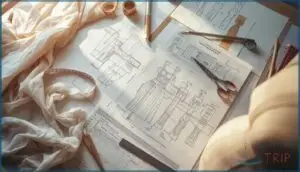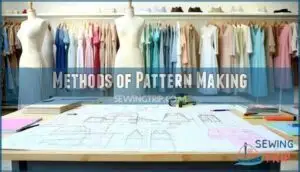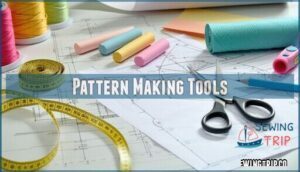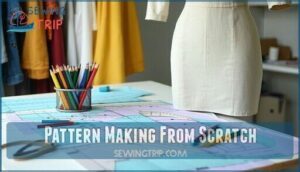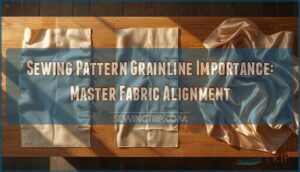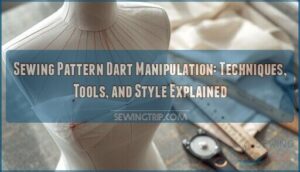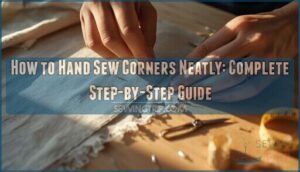This site is supported by our readers. We may earn a commission, at no cost to you, if you purchase through links.
 Pattern making for dresses involves creating paper templates that guide fabric cutting and construction.
Pattern making for dresses involves creating paper templates that guide fabric cutting and construction.
You’ll start with basic measurements and draft a bodice block, then add sleeves and skirt sections.
Essential tools include rulers, curves, and pattern paper.
Two main methods exist: flat pattern making, where you draw on paper using measurements, and draping, where you shape fabric directly on a dress form.
Begin with simple A-line or shift dress patterns before tackling complex styles.
Master dart placement, seam allowances, and grading between sizes.
Each pattern becomes your blueprint for consistent, well-fitted garments.
The secret lies in understanding how fabric behaves around body curves.
Table Of Contents
- Key Takeaways
- Dress Pattern Basics
- Methods of Pattern Making
- Essential Tools for Pattern Making
- Pattern Making Techniques
- Pattern Making for Beginners
- Pattern Making From Scratch
- Dress Pattern Making Techniques
- Pattern Making for Different Dress Styles
- Advanced Dress Pattern Making Techniques
- Troubleshooting Common Pattern Making Issues
- Frequently Asked Questions (FAQs)
- Conclusion
Key Takeaways
- You’ll need to master basic bodice and skirt blocks first – these foundation patterns become your blueprint for creating countless dress designs with proper fit and professional results.
- You can choose between flat pattern making (drawing on paper using measurements) and draping (shaping fabric on a dress form), with flat cutting being more beginner-friendly and mathematically precise.
- You’ll achieve the best results by starting with simple A-line or shift dress patterns before tackling complex styles like wedding or evening gowns that require advanced techniques.
- You must test your patterns through muslin fitting before cutting final fabric – even experienced designers create 12-15 pattern iterations to perfect a single dress design.
Dress Pattern Basics
Understanding dress patterns starts with knowing the five key pattern types that transform your design ideas into wearable garments.
You’ll work through dress making patterns, line drawings, working patterns, development patterns, and production patterns to create clothes that fit perfectly and look professional.
Dress Making Pattern
Every successful dress begins with a solid dress making pattern—your creative blueprint that transforms sketches into stunning garments.
Think of pattern drafting dresses like mapping a journey; each line guides your fabric toward the perfect fit.
Every great dress begins with a single, perfectly placed line that transforms your vision into reality.
Your dressmaking patterns control these essential elements:
- Pattern alterations that customize fit to your unique measurements
- Grain lines that determine how fabric drapes and moves
- Seam allowance calculations for professional finishing
- Fabric choice considerations that affect drape and structure
- Design adaptation possibilities for endless style variations
Line Drawing
Strong line drawing forms the backbone of accurate dress pattern making. You’ll master technical sketching by creating smooth, clean lines that frame your design vision. Line weight variations highlight structure while contour lines add dimensional depth to your fashion illustration.
| Drawing Element | Purpose |
|---|---|
| Light Lines | Initial sketching and construction |
| Medium Lines | Main design features |
| Heavy Lines | Emphasis and silhouette definition |
Practice croquis regularly to develop precision. These accurate outlines enhance communication during flat pattern drafting, transforming your dress patterns from concept to reality seamlessly. Developing precision and mastering technical sketching are key to successful fashion illustration.
Working Pattern
Precision becomes your best friend when creating a working pattern—the bridge between your dress design vision and reality.
This essential step in dress pattern making transforms sketches into functional dress patterns ready for fabric choice and construction.
Your working pattern delivers:
- Pattern accuracy that eliminates costly fabric mistakes
- Fit adjustments customized to your exact measurements
- Design translation from concept to wearable garment
- Pattern lifespan for countless future projects
- Confidence knowing your pattern works perfectly
Development Pattern
A development pattern transforms your working pattern into something truly wearable.
You’ll refine fit adjustments, ease refinement, and movement considerations during this pivotal stage.
Think of it as your dress pattern’s evolution from concept to reality.
| Pattern Evolution Stage | Key Focus Areas |
|---|---|
| Fit Adjustments | Body measurements, dart placement, seam positioning |
| Ease Refinement | Comfort allowances, fabric drape, wearing ease |
| Movement Considerations | Joint flexibility, walking room, arm reach |
This development pattern bridges creativity with functionality, incorporating design integration through precise pattern making techniques.
You’re creating dress patterns that actually work for real bodies in motion.
Production Pattern
Your development pattern becomes a production pattern when you fine-tune it for industrial production.
This final version perfects grading techniques, seam allowances, and fabric consumption calculations.
You’ll add precise notch placement and quality control markers that factories need.
Test everything through sample construction to verify your dress patterns meet manufacturing standards.
This transforms your dress pattern making from concept to reality.
Methods of Pattern Making
You’ll find five main methods to create dress patterns, each with unique advantages for different skill levels and project needs.
These techniques include 2D pattern making, pattern drafting, pattern development, tracing existing clothes, and garment deconstruction, giving you multiple pathways to transform your design ideas into wearable patterns.
2D Pattern Making
2D pattern making transforms your dress ideas into flat patterns without a dress form.
You’ll work with paper templates to create precise measurements and shapes.
This flat pattern drafting method relies on mathematical calculations rather than draping fabric.
Here’s your roadmap to success:
- Master block development – Draft your basic bodice and skirt blocks first
- Perfect dart placement – Position darts for proper fit and shape
- Add seam allowance – Include extra fabric for construction and adjustments
Pattern Drafting
Building on 2D pattern making, you’ll discover that pattern drafting creates the blueprint for every dress.
This method uses measurement accuracy and mathematical precision to develop drafting basic blocks from scratch. Start with block development for bodice and sleeve pieces using your exact measurements.
Focus on fit refinement through careful calculations and ease considerations for comfort. Flat pattern drafting offers endless customization options – you can adjust bust darts, modify necklines, or change sleeve styles.
These pattern making techniques transform numbers into perfectly fitted dress pattern making foundations.
Pattern Development
Once you’ve mastered pattern drafting, it’s time to transform your basic blocks into polished, wearable designs.
Pattern development bridges the gap between your initial draft and a finished garment that moves with your body.
This stage refines your dress pattern making through strategic improvements:
- Fit adjustments that perfect body contours and silhouette
- Ease refinement balancing comfort with style precision
- Movement considerations ensuring natural body motion
- Design translation from concept to functional pattern pieces
- Pattern iteration through testing and perfecting multiple versions
Tracing Your Clothes
Your favorite dress holds the blueprint for countless new creations.
Tracing clothes transforms beloved garments into reusable dress patterns through careful outlining on paper.
Place your garment flat, mark seam allowance lines, and note grain direction for accurate style replication.
This method preserves perfect fits while enabling fabric choice flexibility.
Remember alteration tips when adapting traced patterns—your wardrobe becomes a treasure trove of dress pattern making inspiration for future garment construction projects.
Garment Deconstruction
Taking apart your old clothes reveals the secrets of professional dress pattern making. Garment deconstruction teaches you how designers think and build their creations from the ground up.
Seam Removal reveals construction methods, while Piece Identification shows pattern shapes. Fabric Analysis helps you understand drape and weight choices. Reverse Engineering transforms worn favorites into reusable templates.
- Use a seam ripper to carefully separate pieces without damaging fabric edges
- Label each pattern piece with its original position and grain direction
- Measure seam allowances to understand the designer’s construction approach
- Photograph the original garment before deconstruction for reference during Pattern Replication
Essential Tools for Pattern Making
You’ll need the right tools to transform your dress ideas into accurate patterns that actually work.
From software like Adobe Illustrator and Valentina to physical tools like measuring tapes and French curve rulers, having proper equipment makes the difference between patterns that fit perfectly and ones that don’t.
Having the right tools is crucial for achieving perfectly fitting patterns, and this includes a range of software and physical tools.
Pattern Making Software
Pattern making software transforms your design process from tedious hand-drawing to efficient digital creation.
Today’s tools offer powerful features for crafting professional digital dress patterns. Many designers now utilize specialized software options for creating patterns.
Consider these key factors when selecting pattern drafting software:
- Software Cost – Free options like Valentina versus premium tools with advanced automation plugins
- Feature Comparison – Pattern automation capabilities, grading tools, and measurement integration
- User Experience – Interface design and file compatibility with other programs
Adobe Illustrator
Adobe Illustrator transforms dress pattern making with its vector pattern scaling capabilities.
You’ll create custom block creation designs that resize without losing quality.
The software’s precise pattern design tools let you draft digital dress patterns with mathematical accuracy.
Use the offset path feature for seam allowances and group pattern pieces for organization.
Export your Illustrator sewing patterns as PDFs for easy printing, making this pattern drafting software perfect for both beginners and professionals.
For home sewing projects, it’s a great way to start, but consider other options for professional pattern making.
Valentina
While Adobe Illustrator offers precision, Valentina stands out as open-source pattern making software that won’t break your budget.
This 2D pattern making powerhouse uses Valentina formulas to create parametric patterns that automatically adjust to different body measurements.
Valentina’s key strengths include:
- Customization options for unique design requirements
- Interface usability that welcomes beginners and pros alike
- Open-source advantages with no licensing fees
- Formula-based pattern making techniques for precision
- Active community support and frequent updates
Affinity Designer
Many designers discover Affinity Designer as a budget-friendly alternative to Adobe Illustrator for dress pattern making.
This pattern making software excels at Vector Pattern Scaling and Custom Block Creation, making pattern digitizing straightforward.
You’ll create precise digital dress patterns without breaking the bank.
| Feature | Benefit |
|---|---|
| Affinity Interface | User-friendly design tools |
| File Compatibility | Seamless export options |
| Pattern Digitizing | Professional digital patterns |
Pattern Making Tools
After selecting your software, you’ll need the right pattern making tools to bring your designs to life.
French curves help create smooth, professional lines while tracing tools facilitate accurate transfers.
Measuring tape and rulers provide the precision needed for dress pattern making.
Sharp cutting implements make clean cuts through pattern paper, and marking tools like chalk let you make adjustments easily.
Quality drafting equipment transforms your digital designs into physical patterns.
These measuring tools work together to create patterns that fit perfectly every time.
Many designers source their pattern making supplies online.
Pattern Making Techniques
You’ll discover three main techniques that transform your design ideas into real dress patterns: flat cutting, draping, and contouring.
Each method offers different advantages, so you can choose the approach that works best for your skill level and the type of dress you’re creating, using techniques like draping to achieve your goals.
Flat Cutting
Flat cutting transforms your fabric into precise dress patterns through careful planning and execution.
This foundational pattern making technique requires attention to detail and systematic approach.
Master these essentials:
- Fabric Grain – Align patterns with the fabric’s natural weave direction for proper drape and stability.
- Cutting Layouts – Arrange pattern pieces efficiently to minimize waste while respecting grain lines.
- Seam Allowances – Add consistent margins around each piece for professional construction results.
- Notches Placement – Mark alignment points accurately using pattern weights for seamless assembly later.
Draping
Draping transforms flat fabric into sculptural masterpieces on your dress form. Unlike flat cutting’s rigid measurements, draping lets you work with fabric’s natural flow and movement. You’ll pin muslin directly onto the form, watching your design come alive through hands-on manipulation.
Start by marking key reference points on your dress form with style development in mind. Pin your fabric strategically, allowing gravity and fabric pinning techniques to guide the drape. This 3D design approach reveals how your dress patterns will actually behave on the body.
3D effects
Bias cutting becomes intuitive through draping, letting you discover unexpected design possibilities. Draping is a process that allows for hands-on manipulation and enables you to work with the fabric’s natural flow and movement. By following these steps, you can create a perfect dress design and achieve a base draping setup. This approach helps you understand how to create 3D effects and make accurate muslin fitting. With practice, you will be able to define bust, waist lines and mark seam allowance with ease.
Contouring
While draping shapes fabric on forms, Fabric Contouring takes Body Shaping further by creating precise 3D Effects that hug every curve.
This pattern making technique achieves Fit Precision through strategic seam placement and dart manipulation.
You’ll master Silhouette Creation by mapping natural body lines, adjusting ease, and testing adjustments on basic dress patterns before finalizing your contouring masterpiece.
Pattern Making for Beginners
You’ll start with simple patterns like skirts and sleeves to build your confidence before moving to complex designs.
These beginner tutorials teach you the basic skills you need to create well-fitting dress patterns using clear, step-by-step instructions.
Beginner / Intermediate Pattern Making Tutorials
Once you’ve learned the techniques, applying them through structured tutorials transforms your skills from theory to practice. Beginner pattern making starts with foundational projects that build confidence step by step.
Start your journey with these core pattern making tutorials:
- Skirt Tutorials – Master basic A-line and straight skirts before tackling complex designs
- Bodice Essentials – Learn upper bust measurements and dart placement fundamentals
- Sleeve Guides – Draft basic sleeve blocks and understand cap height relationships
- Collar Projects – Create professional-looking shirt collars using single pattern pieces
These tutorials guide you through dress patterns systematically. Focus on accurate measurements and proper sewing techniques. Sewing blogs can provide extra help. Each project builds skills you’ll use in advanced pattern making.
Making Skirt Patterns
Skirt pattern making starts with a basic skirt block – your foundation for countless skirt style variations. Master skirt drafting fundamentals first, then explore different skirt styles.
Here’s your roadmap:
- Draft your basic A-line skirt pattern with proper measurements
- Learn waistbands explained – from elastic to fitted options
- Practice hem finishes for clean, professional edges
- Master adding pockets for functional design elements
Smart fabric choice transforms any pattern into something special.
Sleeve Pattern Making Tutorials
Sleeve pattern making transforms ordinary dresses into perfectly fitted garments.
You’ll master set-in sleeves and raglan sleeves by starting with a basic sleeve block.
Focus on sleeve ease for comfortable movement and experiment with different sleeve styles.
Practice cuff variations to add personality to your designs.
Altering sleeves becomes simple once you understand fitting principles.
Sleeve patterns require patience, but the results are worth it.
Many designers start with a set-in sleeve pattern for its versatility.
Sleeve patterns require patience, but the results are worth it.
Collar Pattern Making Tutorials
Mastering collar pattern making transforms ordinary garments into polished designs. Start with simple Peter Pan collar or sleek mandarin collar styles before advancing to complex variations.
Focus on precise collar drafting measurements and seamless collar fitting to your neckline. Remember that collar alterations often require multiple test runs—even experienced sewers make adjustments.
- Practice collar patterns on muslin before cutting final fabric
- Use collar drafting rulers for accurate curve measurements
- Test collar fitting on dress forms for proper drape
- Study advanced collars like sailor or convertible styles
- Master collar alterations through systematic fitting adjustments
Pattern Making From Scratch
When you create patterns from scratch, you’ll start with your body measurements and draft basic blocks that serve as the foundation for any dress design.
This method gives you complete control over fit and style, allowing you to build custom patterns that match your exact measurements and design vision, providing a way to achieve your exact measurements.
Creating a Working Pattern
Your pattern-making blueprint transforms sketches into wearable reality.
Start creating a working pattern by selecting fabric that matches your design vision and calculating ease for comfortable movement.
Mark all pattern adjustments clearly on your draft.
Always complete muslin fitting before cutting your final fabric—this vital step reveals necessary modifications through sample construction.
Consider fabric considerations and style variations during design translation.
These dress construction techniques guarantee your dress patterns fit perfectly every time.
Drafting Basic Blocks
Once you’ve got your working pattern ready, it’s time to build your foundation blocks. Think of basic blocks as your pattern-making building blocks—they’re the starting point for every dress you’ll ever create.
Here’s your drafting roadmap:
- Bodice Block – Your upper body foundation
- Sleeve Block – Perfect arm fit every time
- Skirt Block – Lower body base pattern
- Pant Block – Trouser foundation piece
- Custom Fit measurements for accuracy
These slopers become your go-to templates for endless design possibilities.
Sloper Development
After drafting basic blocks, your sloper becomes the blueprint for countless designs.
Think of sloper development as creating your personal dress template—one that fits you perfectly every time.
Start with measurement accuracy to guarantee your bodice block and skirt block match your body.
Then explore customization options through sloper fitting adjustments.
| Development Stage | Focus Area | Key Action |
|---|---|---|
| Initial Setup | Measurement Accuracy | Take precise body measurements |
| Block Creation | Bodice/Skirt Foundation | Draft your base sloper |
| Refinement | Sloper Fitting | Test and adjust for perfect fit |
| Adaptation | Design Variations | Create style variations from your sloper |
Your sloper releases design adaptations and style variations, transforming one foundation into endless dress possibilities.
Dart Manipulation Techniques
Several dart manipulation techniques transform basic dress patterns into stunning designs.
Dart pivoting moves darts to new locations, while slash spreading creates flare or gathers.
Master different dart types like contour darts for curves and waist shaping.
Convert darts into style lines, pleats, or gathers for creative alternatives.
These pattern making techniques give you complete control over fit and design aesthetics.
Dress Pattern Making Techniques
You’ll learn to transform your basic patterns into professional dress designs through working pattern development and production pattern creation.
These techniques bridge the gap between your initial sketches and the final patterns ready for sewing, ensuring proper fit and construction details.
Working Pattern Development
The working pattern transforms your initial draft into a refined blueprint that bridges creativity with precision.
This development stage focuses on perfecting every detail through careful testing and adjustment. You’ll refine slopers with ease calculations, then create muslin mockups to identify fit issues before cutting precious fabric.
Master these essential refinement areas:
- Fit adjustments: Fine-tune proportions for flattering silhouettes
- Ease refinement: Balance comfort with style seamlessly
- Movement considerations: Confirm natural body motion flows
- Pattern truing: Perfect curves and seamlines for professional results
This polished working pattern guarantees confident sewing success.
Production Pattern Creation
Production patterns serve as the final blueprint for industrial production, transforming your creative vision into factory-ready specifications.
You’ll lock in every detail to guarantee consistent manufacturing results across all grading sizes.
- Verify pattern accuracy through thorough sample testing and pattern alterations
- Add precise seam allowances with consistent measurements throughout
- Mark notches placement for accurate assembly alignment
- Apply grading rules systematically for size consistency
- Test dress patterns thoroughly before approving for production runs
This painstaking process guarantees professional-quality pattern making results.
For achieving accurate results, consider using essential pattern making tools.
Pattern Making for Different Dress Styles
Each dress style requires specific pattern adjustments to achieve the perfect fit and silhouette you want.
You’ll need to modify basic blocks differently for a flowing maxi dress versus a fitted bodycon style, since each design presents unique challenges with proportions and fabric drape.
Pattern Making for Maxi Dress
Maxi dress patterns offer endless possibilities for creating flowing, elegant garments. Fabric selection drives your design—choose lightweight cottons for casual wear or silk for formal occasions.
The maxi silhouette flatters most body types through strategic fullness control around the waist and hips.
Consider hemlines options like asymmetrical cuts or high-low styles for visual interest. Adjusting length requires measuring from waist to desired hem point.
These dress design patterns transform simple sewing patterns dresses into stunning statement pieces through thoughtful pattern making for maxi dress techniques.
Pattern Making for Bodycon Dress
Creating bodycon dress patterns requires mastering stretch fabric properties and negative ease calculations.
You’ll need contour shaping techniques that hug every curve precisely. Focus on strategic seam placement to enhance the silhouette while incorporating proper lining techniques for comfort.
For example, adjusting bodice length can greatly improve the overall fit of the dress.
Your pattern making for bodycon dress success depends on understanding how stretch percentages translate into that coveted second-skin fit without compromising movement.
Pattern Making for Skirt Dress
While bodycon dresses hug every curve, skirt dresses offer freedom and versatility.
You’ll discover skirt style variations from classic A-line to dramatic circle cuts transform your designs.
Master waistline shaping techniques to create flattering silhouettes, while hemline finishes like scalloped edges add personality.
Your fabric selection determines drape—choose cotton for structured A-line skirt blocks or silk for flowing designs.
Fit customization through dart placement guarantees comfort.
Start with basic skirt patterns, then modify your skirt block for endless possibilities in pattern making for skirt dress creations.
Advanced Dress Pattern Making Techniques
Advanced Dress Pattern Making Techniques – Introduction
Once you’ve mastered basic pattern making, you’re ready to tackle complex dress styles like lace, wedding, and evening gowns that require specialized techniques.
These advanced methods will help you create professional-quality patterns for formal occasions and intricate fabric types, allowing you to work with a variety of formal occasions.
Pattern Making for Lace Dress
Lace dress patterns require delicate handling and strategic planning. Choose your Lace Selection carefully, considering drape and transparency.
When working with lace, every detail matters—from transparency to drape, your fabric choice shapes the entire dress.
Pair with Underlay Fabrics for coverage and structure. Seam Finishes like French seams prevent fraying while maintaining elegance.
Plan Motif Placement to balance visual weight across the garment. Stabilizing Lace prevents stretching during construction, ensuring your dress patterns maintain their intended shape and beauty.
For a simple project, consider using a Colette Moneta pattern.
Pattern Making for Wedding Dress
Wedding dress patterns demand fastidious planning beyond typical garment construction. You’ll work with delicate fabrics like silk and lace while mastering bodice construction techniques that incorporate corset integration for proper support.
Train construction varies dramatically based on your chosen silhouette—from chapel to cathedral lengths. A project can take significant time, so plan to spend over 100 hours on the dress.
Bridal Silhouettes require specific fitting nuances:
- Ball gown perfection – Your princess moment deserves flawless execution
- Mermaid magic – Curves that make hearts skip beats
- A-line elegance – Timeless beauty that never disappoints
- Sheath sophistication – Sleek lines for modern brides
Pattern making for wedding dress involves strategic embellishment techniques and train styles that’ll create your dream gown.
Pattern Making for Evening Dress
Evening dress patterns demand sophistication that sets them apart from casual wear.
While wedding dress patterns focus on tradition, evening dress patterns celebrate dramatic flair and personal style.
Pattern making for evening dress requires mastering several key elements:
- Formal silhouettes that create stunning visual impact through A-line, mermaid, or column shapes
- Fabric selection with luxurious materials like silk, chiffon, or taffeta that drape beautifully
- Embellishment techniques including beadwork, sequins, or lace appliqué for added glamour
- Train construction for dramatic floor-sweeping effects without compromising movement
- Understructure design with built-in boning or cups for proper support and shape
- Strategic seam placement that enhances your figure while allowing comfortable wear.
Your evening dress patterns don’t need couture training to achieve professional results.
Quality pattern making techniques combined with careful attention to fit and finishing will create show-stopping gowns perfect for galas, proms, or special celebrations.
Troubleshooting Common Pattern Making Issues
When you’re making dress patterns, problems like uneven seams, poor fit, or confusing measurements can slow down your progress and create frustration.
You’ll learn practical solutions to fix these common issues and get your pattern making back on track quickly, which will help you achieve a better fit.
Solving Pattern Making Problems
Pattern making problems feel like puzzles waiting for solutions. Your fabric compatibility determines success before you even start cutting.
Common fit issues have straightforward fixes:
Grainlines problems often cause wonky draping. Design interpretation mistakes happen when you rush measurements.
Test pattern alterations on scraps first. French curves improve accuracy for dress patterns requiring precision fitting.
Overcoming Pattern Making Challenges
Most pattern making challenges stem from common mistakes that you can easily fix with focused practice.
When fit issues plague your dress patterns, step back and evaluate your foundation work first.
Here’s how to tackle the trickiest pattern making problems:
- Master measurement accuracy by double-checking all body measurements and transferring them precisely to your pattern pieces
- Choose fabric wisely for complex designs – lightweight cottons work best for beginners while structured fabrics require advanced pattern making techniques
- Develop your skills gradually through consistent practice with pattern alterations before attempting intricate dress patterns
Patient skill development beats rushing every time.
Frequently Asked Questions (FAQs)
What is the most efficient pattern making method in dressmaking?
For beginners, you’ll find tracing existing garments the most efficient method.
Simply disassemble a well-fitting dress at the seams, trace each piece onto paper, and you’ve got your custom pattern ready.
How to design a dress for beginners?
Starting simple sketches sparks success! You’ll sketch your dream dress first, then draft basic blocks using your measurements.
Start with simple silhouettes like A-line dresses, master fit adjustments, and gradually tackle more complex designs.
What kind of paper do you use for dress patterns?
You’ll want large sheets of kraft paper, butcher paper, or Swedish tracing paper for durability.
Avoid newspaper—it tears easily.
Pattern paper should handle erasing, folding, and multiple uses without falling apart during your drafting process.
How do I become a clothing pattern maker?
Think you’ll magically transform into a pattern wizard overnight?
Start by mastering basic blocks through drafting and draping techniques.
Practice with simple garments, learn measurement skills, and gradually build your technical expertise through consistent hands-on experience.
How do you make a dress pattern?
You’ll draft a basic bodice block using your measurements, then modify it for your design.
Start with paper, measuring tape, and ruler.
Draw the front and back pieces, add seam allowances, and cut your fabric carefully.
Can You Make your own dress patterns?
Yes, you can definitely make your own dress patterns.
You’ll need basic tools like measuring tape, paper, and a pencil.
Start with simple designs, then advance to complex styles as your skills develop.
How do you make a good dress?
Like building a house, you’ll need a solid foundation: start with accurate measurements, draft a well-fitting pattern, choose quality fabric, and sew with precision for professional results.
Are dress sewing patterns free?
You’ll find plenty of free dress sewing patterns online through websites, blogs, and YouTube channels.
Many designers offer basic patterns at no cost, while premium or complex designs typically require payment.
How do you make a dress for a wedding?
Start by choosing your dress style and taking accurate measurements.
Create or modify a pattern using basic blocks for the bodice and skirt.
Cut fabric carefully, then sew with precision for your special day.
How do you sew a wedding dress?
Building a wedding dress is like constructing a cathedral—every stitch matters.
You’ll start with your perfected pattern, cut carefully, baste for fitting, then sew seams methodically.
Add closures, hem precisely, and press beautifully.
Conclusion
Professional fashion designers create an average of 12-15 pattern iterations before finalizing a single dress design.
Mastering pattern making for dresses transforms your sewing from guesswork into precision crafting. You’ve learned essential tools, techniques, and troubleshooting methods that’ll serve you throughout your creative journey.
Whether you’re drafting basic blocks or tackling complex evening gowns, these fundamentals guarantee consistent fit and professional results.
Start with simple patterns, practice regularly, and don’t fear mistakes—they’re stepping stones to expertise.
- https://creative-curator.teachable.com/p/drape-contour-for-beginners/
- https://valentinaproject.bitbucket.io/
- https://www.tillyandthebuttons.com/p/stevie.html
- https://simplicity.com/mccalls/pdm8053
- https://dresspatternmaking.com/patternmaking-basics/principles-of-patternmaking/introduction-and-overview-of-patternmaking

